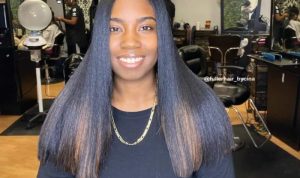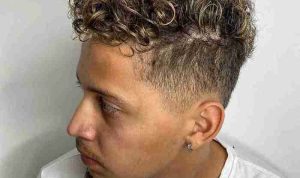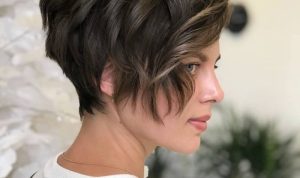Understanding Natural African Hair
Hairstyles for natural african hair – Natural African hair, often referred to as type 4 hair, encompasses a wide spectrum of textures, from tightly coiled kinky hair to looser, more wavy patterns. Understanding the unique characteristics of this hair type is crucial for proper care and styling. This includes recognizing variations in hair porosity (the hair’s ability to absorb and retain moisture) and density (the number of hair strands per square inch).
Historically, various styles have reflected cultural significance and personal expression, evolving from traditional braids and cornrows to more contemporary looks.
Hair Texture, Porosity, and Density
Natural African hair exhibits significant diversity in texture, ranging from fine to coarse strands and varying degrees of curl patterns. Hair porosity, which determines how easily moisture is absorbed and retained, plays a significant role in styling and product selection. High porosity hair absorbs moisture quickly but also loses it just as rapidly, requiring more frequent moisturizing. Low porosity hair struggles to absorb moisture, necessitating the use of products that help open the hair cuticle.
Hair density, the number of hair strands per square inch, influences the overall volume and thickness of the hair, affecting styling choices and product usage.
A Brief History of Natural African Hairstyles, Hairstyles for natural african hair
Natural African hairstyles have a rich history, deeply intertwined with cultural identity and social status. Traditional styles like braids, cornrows, and twists served practical purposes, protecting the hair from harsh environmental conditions and symbolizing tribal affiliations. These styles have evolved and adapted over time, reflecting changing cultural influences and personal preferences. The rise of the natural hair movement in recent years has led to a renewed appreciation for the beauty and versatility of natural African hair, resulting in a vibrant array of contemporary styles.
Popular Natural Hairstyles
Numerous styles cater to the diverse textures and preferences of individuals with natural African hair. The choice of hairstyle often depends on factors such as hair length, density, and desired level of maintenance.
Examples of Natural Hairstyles
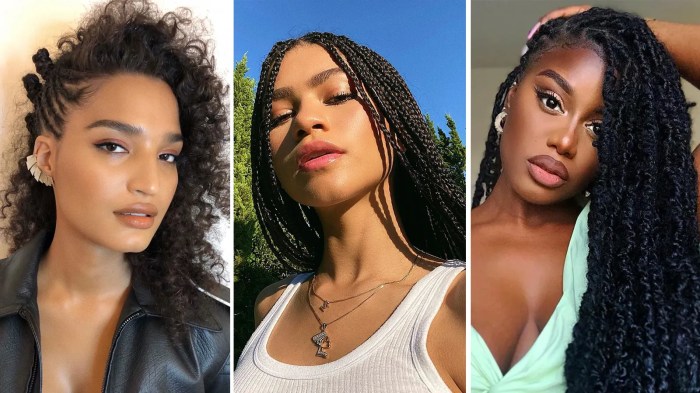
Source: glamour.com
| Hairstyle | Description | Maintenance | Image Description |
|---|---|---|---|
| Braids | Intertwined strands of hair, offering versatility in size, pattern, and complexity. Can range from simple cornrows to intricate box braids. | Moderate to high, depending on style complexity; requires regular washing and moisturizing. | A detailed image of box braids, showcasing neatly sectioned, medium-sized braids extending from the scalp to the ends, with a uniform appearance and minimal frizz. |
| Twists | Two strands of hair wrapped around each other, creating a rope-like effect. Similar to braids, but generally simpler and quicker to achieve. | Moderate; requires regular moisturizing and occasional detangling. | An image of two-strand twists, illustrating clearly defined twists that are evenly spaced and neatly arranged, demonstrating a smooth, consistent texture throughout. |
| Afros | Hair styled to its natural fullness, emphasizing the curl pattern and volume. | Low to moderate; requires regular moisturizing and detangling to prevent matting. | A picture of a voluminous afro, showcasing a full, rounded shape with well-defined curls, exhibiting a consistent texture and bounce throughout the hair. |
| Locs | Sections of hair intertwined and matted together to form cylindrical strands. Requires patience and commitment to grow and maintain. | Low; minimal styling required once locs are established, but regular washing and moisturizing are necessary. | An image of mature locs, showing a collection of uniformly sized and well-defined locs, illustrating a smooth, consistent texture throughout, free from frizz or breakage. |
Creating Natural Hairstyles: Braids, Twists, and Afros
The process for creating these styles varies depending on hair length, texture, and desired look. Generally, braids involve sectioning the hair and interweaving strands. Twists involve twisting two strands together. Afros require minimal manipulation, focusing on defining the natural curl pattern through detangling and the application of moisturizing products.
Maintenance of Natural Hairstyles
Maintenance requirements vary significantly across different hairstyles. Braids and twists generally require less daily styling but may necessitate more frequent washing and moisturizing to prevent dryness. Afros may require daily detangling and moisturizing to maintain their shape and prevent frizz. Locs, once established, require minimal daily maintenance but benefit from regular washing and moisturizing to maintain their health and prevent breakage.
Hair Care Routines for Natural African Hair
A consistent hair care routine is essential for maintaining the health and vitality of natural African hair. This routine should incorporate cleansing, conditioning, moisturizing, and protective measures.
Comprehensive Hair Care Routine
A typical routine includes washing the hair with a sulfate-free shampoo to avoid stripping natural oils. Deep conditioning treatments are essential to replenish moisture and improve hair elasticity. Moisturizing is crucial to combat dryness and breakage, often achieved using leave-in conditioners, oils, and butters. Regular detangling with wide-tooth combs or fingers helps prevent breakage and promotes healthy hair growth.
Benefits of Natural Hair Products
Natural hair products such as shea butter, coconut oil, and jojoba oil provide essential nutrients and moisture, promoting hair health and shine. Leave-in conditioners help retain moisture and detangle hair. The choice of products should align with individual hair porosity and density.
Protecting Natural Hair
Protective measures at night, such as wearing a satin bonnet or scarf, prevent friction and breakage. During physical activities, hair should be styled in protective styles to minimize damage. Use of hair accessories should be mindful to avoid pulling or tugging on the hair.
Styling Products and Tools
Appropriate styling products and tools are essential for achieving desired hairstyles while maintaining hair health. Choosing the right products and tools depends on individual hair type and desired style.
Styling Products
Various products are available, including leave-in conditioners, styling creams, gels, and oils. These products aid in detangling, moisturizing, and defining curls. The selection depends on individual hair needs and desired style.
Essential Styling Tools
Essential tools include wide-tooth combs for detangling, hair clips for sectioning, and diffusers for drying curly hair. Other helpful tools include satin bonnets and scarves for overnight protection.
Styling Techniques
Different techniques, such as finger coiling, twisting, and braiding, can be used to create a variety of styles. The choice of technique depends on the desired hairstyle and hair texture.
Addressing Common Hair Concerns: Hairstyles For Natural African Hair
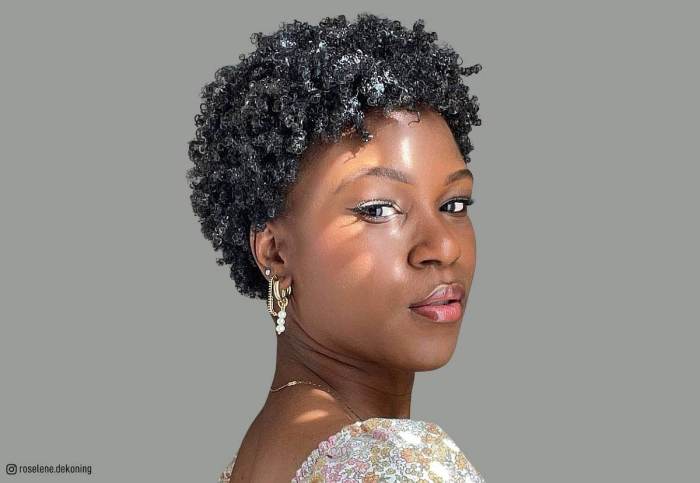
Source: latest-hairstyles.com
Individuals with natural African hair may experience common issues such as breakage, dryness, and shrinkage. Understanding these issues and implementing preventative measures is crucial for maintaining healthy hair.
Common Hair Problems and Solutions
Breakage can result from excessive manipulation, dryness, or heat damage. Solutions include minimizing heat styling, using protective styles, and moisturizing regularly. Dryness is often addressed through consistent moisturizing and deep conditioning. Shrinkage, the reduction in hair length when dry, is a natural characteristic of tightly coiled hair and can be managed through proper moisturizing and styling techniques. Scalp issues, such as dandruff or dryness, can be addressed through gentle cleansing and the use of scalp-specific treatments.
Protective Styling Techniques
Protective styling involves techniques that minimize manipulation and protect the hair ends, promoting length retention and overall hair health.
Natural African hair offers a stunning canvas for diverse styles, from intricate braids to voluminous afros. Many find that shorter cuts are particularly flattering and easy to manage, and for ideas on achieving chic looks with less length, you might find inspiration in resources dedicated to hairstyles for short hair women. Ultimately, the best style will depend on individual hair texture and personal preference, but exploring different options can be a fun journey for anyone with natural African hair.
Benefits of Protective Styling
Protective styles reduce manipulation, minimizing breakage and promoting hair growth. They protect the hair from environmental factors and can simplify daily hair care routines.
Various Protective Styling Methods
Methods include braids, twists, weaves, and wigs. Each method has advantages and disadvantages concerning ease of maintenance, length retention, and style versatility.
Comparison of Protective Styles
| Protective Style | Ease of Maintenance | Length Retention | Style Versatility |
|---|---|---|---|
| Braids | Moderate | High | High |
| Twists | Moderate | High | Moderate |
| Weaves | Low | Moderate | High |
| Wigs | Low | Variable | High |
Inspiration and Trends
Natural African hairstyles draw inspiration from diverse cultural traditions and contemporary trends. Styles can be adapted to suit various occasions and personal preferences.
Cultural and Temporal Inspiration
Styles reflect influences from various African cultures and historical periods. Modern interpretations of traditional styles showcase a blend of heritage and contemporary aesthetics.
Current Trends and Styles
Current trends incorporate elements of natural texture, volume, and length. Popular styles include defined curls, textured waves, and updos that showcase the beauty of natural hair.
Styles for Different Occasions
Styles can be tailored to suit different occasions. Formal events might call for elegant updos or intricate braids, while everyday wear can incorporate simpler styles that are quick and easy to manage.
Top FAQs
How often should I wash my natural African hair?
The frequency depends on your hair’s porosity and lifestyle, but generally, washing every 1-2 weeks is recommended to avoid over-drying.
What are some good ways to detangle natural African hair?
Always detangle gently, starting from the ends and working your way up. Use a wide-tooth comb or your fingers, and apply a leave-in conditioner to minimize breakage.
How can I prevent breakage in my natural African hair?
Minimize heat styling, use gentle hair products, avoid tight hairstyles, and maintain a consistent moisturizing routine.
How can I increase length retention in my natural African hair?
Protective styling, regular deep conditioning treatments, and minimizing manipulation are crucial for length retention.



